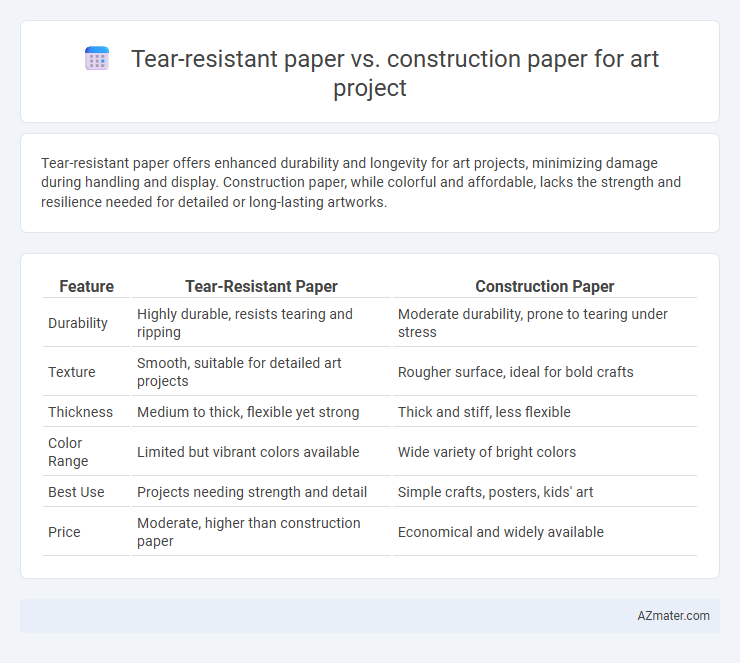Tear-resistant paper offers enhanced durability and longevity for art projects, minimizing damage during handling and display. Construction paper, while colorful and affordable, lacks the strength and resilience needed for detailed or long-lasting artworks.
Table of Comparison
| Feature | Tear-Resistant Paper | Construction Paper |
|---|---|---|
| Durability | Highly durable, resists tearing and ripping | Moderate durability, prone to tearing under stress |
| Texture | Smooth, suitable for detailed art projects | Rougher surface, ideal for bold crafts |
| Thickness | Medium to thick, flexible yet strong | Thick and stiff, less flexible |
| Color Range | Limited but vibrant colors available | Wide variety of bright colors |
| Best Use | Projects needing strength and detail | Simple crafts, posters, kids' art |
| Price | Moderate, higher than construction paper | Economical and widely available |
Introduction to Tear-Resistant and Construction Paper
Tear-resistant paper is engineered with reinforced fibers to withstand ripping, making it ideal for art projects requiring durability and frequent handling. Construction paper features a more porous and textured surface, offering vibrant colors but a lower resistance to tearing. Choosing between tear-resistant and construction paper depends on the project's need for strength versus color variety and texture.
Composition and Manufacturing Differences
Tear-resistant paper is typically made from a blend of natural fibers and synthetic materials, such as polyester or Kevlar, enhancing its durability and resistance to tearing, while construction paper is composed mainly of wood pulp with a loose fiber structure, making it less durable and more prone to ripping. In manufacturing, tear-resistant paper undergoes additional treatments like resin coating or lamination to improve strength and surface smoothness, whereas construction paper is produced through a simpler, lower-cost process focused on vibrant color application rather than structural integrity. These compositional and manufacturing differences make tear-resistant paper ideal for projects requiring longevity and resilience, while construction paper is suited for temporary, colorful art activities.
Durability and Tear Resistance Compared
Tear-resistant paper offers superior durability compared to construction paper, making it ideal for art projects that require frequent handling or manipulation. While construction paper is economical and available in vibrant colors, it tends to tear easily under stress or wet conditions. Choosing tear-resistant paper ensures the artwork maintains structural integrity and longevity during creative processes.
Texture and Surface Qualities
Tear-resistant paper offers a smooth, durable surface ideal for detailed drawing and mixed media applications, maintaining integrity under stress. Construction paper features a coarse, fibrous texture that absorbs paint and glue well, providing a tactile quality favorable for collages and children's crafts. The choice depends on the desired texture effect and the medium used in the art project.
Color Vibrancy and Range
Tear-resistant paper offers superior color vibrancy due to its smooth surface that enhances pigment absorption, making hues appear more vivid and intense compared to construction paper, which tends to have a duller and more muted color range. Construction paper typically features a limited color palette dominated by primary and basic shades, while tear-resistant paper provides an extensive spectrum of rich, saturated colors ideal for detailed art projects requiring bright, bold visuals. For artists prioritizing color brilliance and variety, tear-resistant paper is the preferred choice to achieve striking, long-lasting artwork.
Usability with Various Art Mediums
Tear-resistant paper offers superior durability compared to construction paper, making it ideal for art projects involving wet mediums like watercolor, acrylics, and ink, as it resists ripping and warping. Construction paper, while more affordable and readily available, tends to absorb moisture unevenly and can tear easily with heavy paint, glue, or mixed media applications. For artists requiring versatility with diverse materials such as markers, pastels, collage elements, and paint, tear-resistant paper provides a reliable surface that maintains integrity throughout the creative process.
Suitability for Different Art Techniques
Tear-resistant paper offers enhanced durability, making it ideal for mixed media and wet techniques such as watercolor, acrylic painting, and collage, where repeated handling or layering occurs. Construction paper, while cost-effective and vibrant, tends to tear easily and is best suited for dry media like crayons, markers, and simple cut-and-paste crafts. Artists seeking longevity and resistance to wear should prioritize tear-resistant paper for complex or multi-step art projects.
Cost-Effectiveness for Art Projects
Tear-resistant paper offers durability and longevity for art projects, reducing the need for frequent replacements and thus proving cost-effective over time. Construction paper is generally cheaper initially but may require replacements due to its lower durability, increasing overall costs. Choosing tear-resistant paper optimizes budget efficiency while maintaining quality in long-term art applications.
Eco-Friendliness and Recyclability
Tear-resistant paper is often made from synthetic fibers or heavily treated materials, which can hinder its eco-friendliness and reduce its recyclability compared to traditional construction paper. Construction paper typically consists of natural fibers like recycled pulp, making it more biodegradable and easier to recycle in standard processes. Choosing construction paper for art projects supports sustainable practices by minimizing environmental impact and enhancing recyclability.
Best Applications for Each Paper Type
Tear-resistant paper offers superior durability for projects involving heavy handling, mixed media, or repeated folding, making it ideal for intricate collages, bookbinding, and sculpture assembly. Construction paper excels in brightly colored, easy-to-cut applications such as children's crafts, school projects, and simple paper models due to its affordability and vibrant pigments. Selecting tear-resistant paper ensures longevity and resilience, whereas construction paper prioritizes accessibility and bold color expression for temporary or educational art activities.

Infographic: Tear-resistant paper vs Construction paper for Art project
 azmater.com
azmater.com